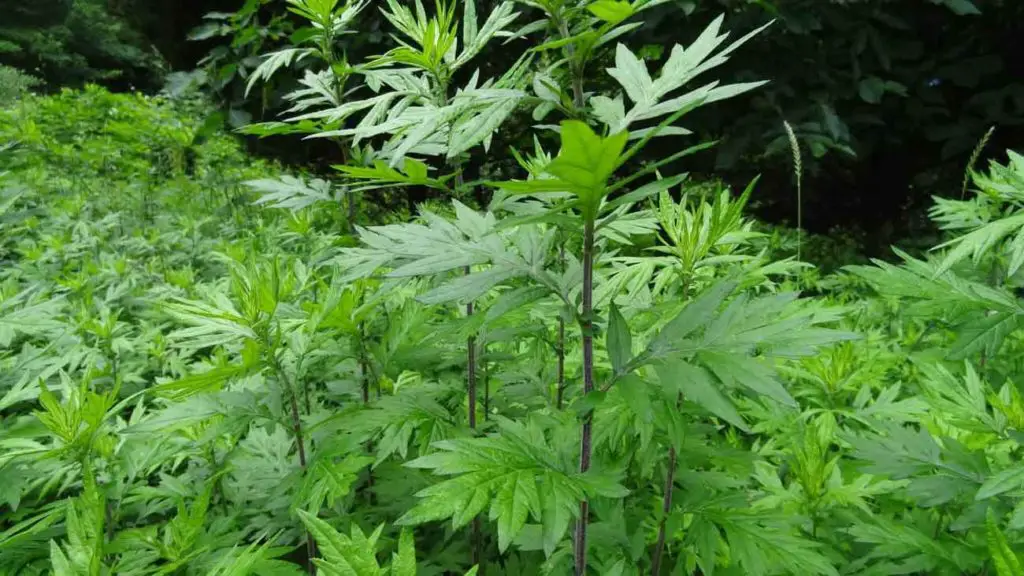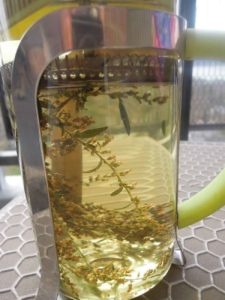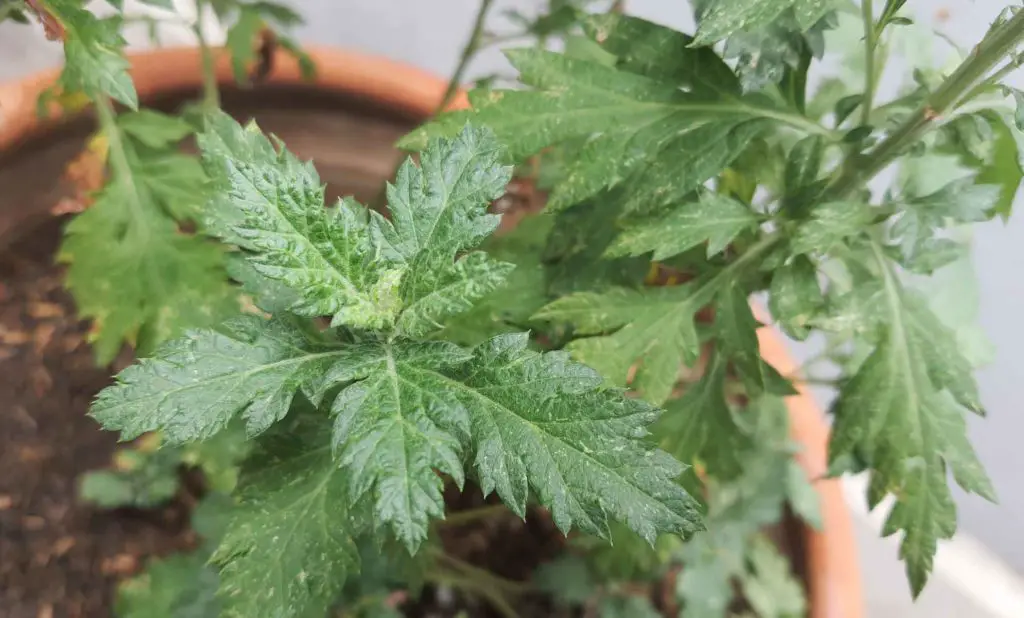What is Mugwort?
Mugwort is one of the common names for the plant Artemisia vulgaris which belongs to the Daisy Family (Compositae). Some other common names include chrysanthemum weed, Damong Maria in Tagalog, Erbaka in Ilocano, Helbas in Bisaya, and St. John’s plant. While closely related, Artemisia absinthium is a true common wormwood and it has traditionally been used to make absinthe. The two plants are similar in appearance, however they can be differentiated. Mugwort leaves have white undersides and pointed ends. Like absinthe, Mugwort was used to flavor alcoholic beverages, specifically beer prior to the use of hops, and this use is one possible source of the plant’s name.
Additionally, Mugwort had applications rooted in superstition. The plant’s common name, St. John’s plant, was derived from folklore claiming that John the Baptist wore Mugwort around his waist. For this reason, many regarded the plant as having the ability to protect against evil spirits, disease, and misfortune. Some, especially those who practice Wicca, maintain some of those beliefs. High respect for the plant also resulted in the development of many folk cures, and it has now been confirmed that Mugwort has many useful medicinal properties.

Mugwort Benefits & Uses
Moxibustion, Smudge Sticks and Smoking Mugwort
While many medical applications of Mugwort use the root, the wooly fibers on the underside of the leaves are sometimes used to create Moxa. Moxibustion is an eastern traditional medicine technique, where a stick made of flammable fibers is lit on one end and applied to pressure points on the skin to stimulate circulation. While not as common as Artemisia argyi, the Artemisia vulgaris leaves can also be used in this technique. Moxibustion has been used to treat pain, cancer, hypertension, and digestive disorders; however there is little scientific evidence to support these claims.
Smudging is another technique that involves burning Mugwort. Smudging is based on Native

American traditions and involves burning the dried stalks, leaves, and flowers of the Mugwort plant. Burning Mugwort releases a clarifying herbal scent that many report to be soothing and mildly sedative. It is also widely reported that Mugwort can enhance dreams, and many often describe Mugwort dreams as extremely vivid and lucid.
The main active ingredient in Mugwort is the compound thujone. Thujone has been found to loosely bind, but not activate cannabinoid receptors. Instead, thujone has been found to activate GABAA receptors. Some people report feeling “high” after taking Mugwort; however this mechanism is different from cannabinoids like THC and much closer to the mechanisms of various sleep medications. Mugwort can also be directly smoked to increase its effects; however many describe Mugwort smoke as harsh when directly inhaled. Therefore it may be preferable to smudge Mugwort if you are seeking to benefit from its sedative effects.
Epilepsy
Like many other compounds that have sedative properties, Mugwort has been used to treat epilepsy and palsy. It is hypothesized that some convulsive disorders are caused by overstimulation of calcium receptors in the brain, and that activation of GABAA receptors may help balance these signals. Therefore, it is reasonable for Mugwort to be used to aid in treating convulsive disorders; however no clinical studies have been conducted to confirm Mugwort as a valid treatment.
Menstruation Aid
Mugwort reportedly stimulates circulation in the pelvic region, and has been used for many years to start or enhance menstruation. This can relieve cramps and discomfort for women and may help regulate a woman’s cycle.
Stomach Ailments
Folk remedies for nausea, colic, and indigestion, often use Mugwort. Teas made of Mugwort are particularly soothing for the digestive system. Teas should not be made too strong as this may cancel out their soothing effects.
Antioxidant
Mugwort has shown potential as a source of natural antioxidants. Treatment with Mugwort resulted in a notable increase in blood glutathione levels, dismutase activity and serum levels as compared to a placebo.
Menopause
Traditionally Mugwort tea has been used to treat hot flashes and other menopause symptoms. There is no modern text to support this claim.
Check out Estafiate which comes from the same Asteraceae as Mugwort.
Mugwort Side Effects
Mugwort may cause dermatitis through either skin contact or ingestion. People with hazelnut allergies should not take Mugwort because cross-reactivity has been identified despite the plants being otherwise unrelated. People with allergies to celery or carrots may also be allergic to Mugwort. Caution should be taken when trying Mugwort for the first time, especially if you have known food allergies. Women that are nursing or pregnant should also not take Mugwort especially since Mugwort may induce menses. There have not been many studies on the dosage of Mugwort that is safe for consumption. Components of Mugwort essential oil are toxic at high levels. Overall, Mugwort is well tolerated when following typical delivery methods (tea, smudging, ect.); however caution should be used when taking Mugwort in concentrated forms.
How to make Mugwort Tea
The stalks, leaves, and roots of the Mugwort plant are often dried. Teas can be made with either dried plants or with the tops of fresh plants. Typically, 1-2 teaspoons of dried herb is sufficient for infusing tea. It is common for Mugwort to be mixed with other herbs when making tea. One such herb, skullcap may enhance dream activity and improve sleep significantly when used in combination with Mugwort. With Mugwort, 1-2 teaspoons of skullcap can be added to hot water to make a pleasant tasting tea that is especially great to drink about an hour before going to bed. Both herbs should be strained from the tea before drinking. Teas are best used to aid with sleep and to treat digestive ailments.

Mugwort Oil
Mugwort oil offers a more concentrated delivery method for the active ingredients in Mugwort. Oils are best used for treating convulsive disorders and menstruation issues. Extreme care should be taken if you may be pregnant as Mugwort oils may have abortive effects. Oils may be applied topically to sore joints and can have a warming effect. Topical applications are not ideal as some may experience rashes in response to Mugwort; therefore moxibustion techniques may be a better choice for treatment of arthritis.
Mugwort Tincture
Occasionally Mugwort is sold as a tincture, but in general, water is a sufficient solvent for the herb. Tinctures and tonics are alternatives to oil and provide a nice middle ground, concentration-wise, between teas and oil. Tonics are best used for convulsive disorder treatments, digestive problems, or irregular menstruation.
How to Grow Mugwort

Mugwort is a resilient plant that commonly grows throughout North America and Europe. It is often treated as a weed because of its ability to readily spread and to recover from mowing. The plant most often reproduces through the generation of new plants from spreading rhizomes rather than from seeds. This causes plants to form dense strands that can reach anywhere from three to five feet tall. Seeds produced by plants grown in North America tend to not be viable; therefore it is often easier to cultivate Mugwort from rhizomes. If growing from seed, gardeners should plant in sandy lime rich soil with seeds spaced 12 to 18 inches apart. New seedlings resemble sprouting chrysanthemums earning Mugwort the name “chrysanthemum weed”. Once mature, leaves have a dark green to purple hue with fuzzy, white undersides. Flowers form tight, white to yellow clusters at the ends of stems during the months of June until September with not all plants coming to seed.
Buying the best Mugwort
Mugwort is legal in the United States and is readily purchased online in many forms. As with all supplements it is important to look at purity. This is especially important when buying Mugwort to smudge or smoke as combustion of impurities may be detrimental to lung health. Concentrated forms of the herb like oils or tinctures should also be relatively pure. The most widely available form of Mugwort is dried and crushed, which is ideal for smoking or making teas, tonics, and tinctures. Mugwort seeds from North America are often not viable, therefore, if seeking to purchase Mugwort for cultivation, it is best to purchase seeds from Europe, “heirloom” seeds, or whole plants.
Mugwort Toxicity
Overall, Mugwort has a long history of medicinal use across many cultures. It can be a powerful treatment for insomnia, palsy, and digestive issues. It is also useful in supporting regular menstruation and joint pain. The plant is extremely resilient and widely available, making Mugwort a cost-friendly supplement. People with allergies should be cautious when trying Mugwort because of similarities with other allergens. Women should also be careful when using Mugwort, especially if they may become pregnant. As with all supplements, it is best to consult your doctor before beginning treatment with Mugwort.
References:
http://www.oardc.ohio-state.edu/weedguide/single_weed.php?id=75
https://oak.ppws.vt.edu/~flessner/weedguide/artvu.htm
http://extension.psu.edu/plants/green-industry/news/2015/mugwort-chrysanthemum-weed
https://www.ncbi.nlm.nih.gov/pubmed/9383261
https://www.ncbi.nlm.nih.gov/pubmed/18930849
https://www.ncbi.nlm.nih.gov/pmc/articles/PMC1375244/





